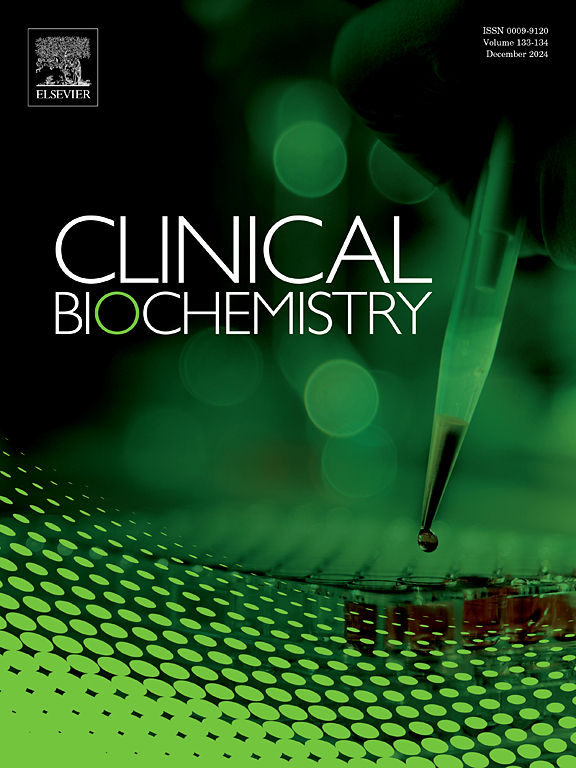Shortcoming of serum B-cell maturation antigen measurement by enzyme-linked immunosorbent assay in one laboratory’s experience: Unsatisfactory assay reproducibility
IF 2.1
3区 医学
Q2 MEDICAL LABORATORY TECHNOLOGY
引用次数: 0
Abstract
Introduction
Serum protein electrophoresis and serum free light chain (SFLC) assays are standard methods for monitoring patients with multiple myeloma (MM). However, patients with non-secretory MM often require invasive bone marrow biopsies to monitor treatment response and disease progression. Recently, serum soluble B-cell maturation antigen (sBCMA) has been proposed as an alternative biomarker for monitoring of MM, including non-secretory disease. We aimed to optimize the performance of and validate a serum sBCMA enzyme-linked immunosorbent assay (ELISA) from R&D Systems for research and eventual clinical use.
Methods and Results
A total allowable error of 25 % was used, with one-third (8.3 %) budgeted for imprecision, one-third for bias, and one-half (12.5 %) as the allowable deviation from linearity. For imprecision, the repeatability coefficient of variation (CV) was acceptable, but the within-laboratory CV was not. We were limited in our ability to assess accuracy, but recovery of the ELISA standards was acceptable, and the sBCMA concentrations determined in various patient populations compared well to previous publications. The sBCMA concentration also correlated significantly with the M−protein concentration and the involved/uninvolved SFLC ratio. The sBCMA ELISA was verified to be linear within the allowable deviation between 99.04–1179.36 pg/mL. We attempted to confirm stability of serum sBCMA stored at room temperature, 4 °C, and −20 °C for up to 50 weeks, but the assay reproducibility was too poor for this to be assessed adequately.
Conclusion
Despite efforts to optimize the performance of the ELISA, the results were not reproducible enough over time to allow us to implement this sBCMA ELISA for clinical use.
用酶联免疫吸附法测定血清b细胞成熟抗原的缺点:在一个实验室的经验:不满意的测定可重复性
血清蛋白电泳和血清游离轻链(SFLC)检测是监测多发性骨髓瘤(MM)患者的标准方法。然而,非分泌性MM患者通常需要侵入性骨髓活检来监测治疗反应和疾病进展。最近,血清可溶性b细胞成熟抗原(sBCMA)被提议作为监测MM(包括非分泌性疾病)的替代生物标志物。我们的目标是优化和验证R&;D Systems公司的血清sBCMA酶联免疫吸附试验(ELISA)的性能,用于研究和最终的临床应用。方法与结果采用总允许误差为25%,其中三分之一(8.3%)为不精确,三分之一为偏倚,一半(12.5%)为允许偏离线性。对于不精确,重复性变异系数(CV)是可以接受的,但实验室内的CV是不可接受的。我们评估准确性的能力有限,但ELISA标准的恢复是可以接受的,并且在不同患者群体中测定的sBCMA浓度与以前的出版物相比很好。sBCMA浓度也与M -蛋白浓度和参与/未参与SFLC比值显著相关。验证sBCMA ELISA在99.04-1179.36 pg/mL允许偏差范围内呈线性。我们试图确认血清sBCMA在室温、4°C和- 20°C下保存长达50周的稳定性,但该试验的重现性太差,无法充分评估。结论尽管对ELISA的性能进行了优化,但随着时间的推移,结果的可重复性不够,因此我们无法将该sBCMA ELISA应用于临床。
本文章由计算机程序翻译,如有差异,请以英文原文为准。
求助全文
约1分钟内获得全文
求助全文
来源期刊

Clinical biochemistry
医学-医学实验技术
CiteScore
5.10
自引率
0.00%
发文量
151
审稿时长
25 days
期刊介绍:
Clinical Biochemistry publishes articles relating to clinical chemistry, molecular biology and genetics, therapeutic drug monitoring and toxicology, laboratory immunology and laboratory medicine in general, with the focus on analytical and clinical investigation of laboratory tests in humans used for diagnosis, prognosis, treatment and therapy, and monitoring of disease.
 求助内容:
求助内容: 应助结果提醒方式:
应助结果提醒方式:


